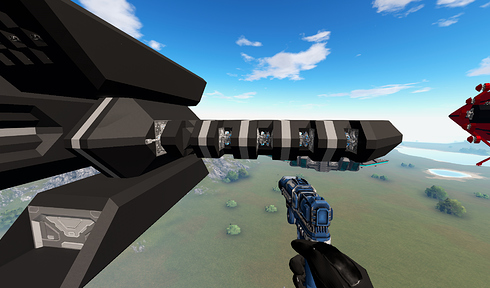Hello, welcome to the CV guide. I’m your host Zackey_TNT and this guide will assume that you have fully read and understood all chapters of the SV guide found here
CV design is very similar to SVs and aren’t very complex or different, so this will be a brief overview of what’s different.
Chapter 1. CV Design.
Subsection 1. System Design
Functionally, the same concepts from SVs apply. Grouped approach tends to be the best option, with a bit of clustered systems to provide redundancies. You should be using combat steel blocks only, as CVs do not have difficulties with thrust. It is recommended to build to the size of the playfield. Make sure you have a class 7 CV and a class 1 CV for pvp playfields that need it. Also of note is that upclassing tends to be more relevent to CVs as their size opens up a lot of surfaces. I recommend 6.50 as being the maximum, as I have found any more to be taken. I would recommend class 1.46 for class 1 CVs, as they have less blocks.
On the topic of hangers:
If you must have them on a PvP ship, use them as air gaps to stop lagshot. Vehicles in the hanger can completely stop a shot dead in its tracks as well, so they are quite effective at soaking lagshots.
Just don’t prioritize it as hangers are not a functional part of the ship during combat.
On the topic of thrusters:
It’s almost universally agreed that for class 7 CVs, always use the largest available thruster, as they are universally superior statistically. The only case where you might use a smaller thruster is on class 1 CVs in which space is limited, but even still, simply providing more redundant thrusters is a better idea then swapping out for a smaller one!
Subsection 2. Lagshot Design.
Lagshot, just like it’s SV counterpart, is done with shutters. There is a minor difference in design however. CVs can make use of “pikes” or “pyramids” to increase resistance to lagshots, due to their increased class size over SVs. These pikes/pyramids aren’t as effective as shutters, but they do catch some lagshot and are a lot more triangle efficient. Ingame name: Pyramid A
Note: These blocks should be used to supplement a shutter based lagshot system, not replace it.
The only other thing worth noting is that using pyramids as a wall to protect your thrusters is a good idea, just don’t do it with shutters. Shutters should be placed around devices of importance.
Chapter 2. Turret Placement & Decoys
Subsection 1. Turret Configurations.
In CV design, there are multiple different turret layouts, but we’ll be covering the most popular ones.
Firstly, Ring Turrets:
Pretty simple concept, turrets are put on a ring around the craft. The advantage is that all turrets are able to fire forwards at the target, and are extended off from the craft so as to attract fire away from main hull. These are typically seen on larger craft, and are very expensive in triangle and class size, so be careful.
Here’s an example:
Secondly: Flat-top Turrets
These are the simplest form of turret layout, and basically involve putting all of your turrets on the top of your craft, closest to your crosshair. The advantage is that this layout is extremely simple to set up and very user-friendly, since they are able to shoot anything your crosshair is placed on. The disadvantage is the turrets don’t have as much coverage, especially from the bottom.
Here’s an example:
Thirdly, and finally: Slotted Turrets
These turrets are put vertically in slots on the wings or other raised platform. The advantage of this configuration is that turrets are extremely well defended, often being almost entirely merged into the hull itself, the downside is reduced coverage. It’s also costly in class size and triangles, due to opening up more surface area.
Here’s an example:
Subesction 2. Decoys.
Let’s talk decoys. Firstly, realize that generators are still used as decoys just as they are with SVs.
It’s recommended to place a few of them in the nose of your vessel so that other turrets fire at them. Most CVs will give up a turret to be a decoy.
This is because other CVs sometimes swap targets to only turrets, in which case, all the damage starts going to your turrets instead of your hull.
I usually use rocket turrets for this role as they do less damage against other CVs then Plasma. Note that gatling & sentry turrets are not valid decoys, because they are not targetted!
Consider adding lagshot defense to these turrets, as it will prevent it from being damaged before the armor is breached.
I recommend placing one or two turrets in your hull as a decoy.
Subsection 3. Turret Loadouts.
In CVs, you can use different types of CV turret loadouts. For example, you can either have 10 plasma, or 10 laser, or 5 of each. Here’s the three most common ones:
Anti-SV:
Flak (Tracks targets better)
Laser (Causes lagshots against SVs)
Arty (All CVs use this)
Cannons (All CVs use this)
Anti-CV (most common):
Rocket (Better damage/block removal against CVs then Flak)
Plasma (Better damage/block removal against CVs then laser)
Arty (All CVs use this)
Cannon (All CVs use this)
Balanced:
Rocket (Better damage/block removal against CVs then Flak)
Laser (Able to deal with SVs as well as CVs)
Arty (All CVs use this)
Cannon (All CVs use this)


